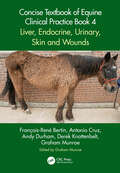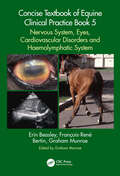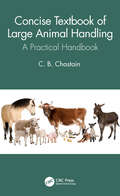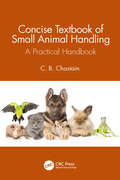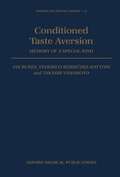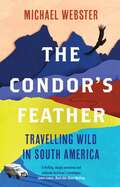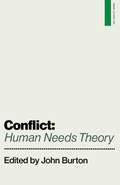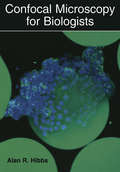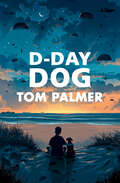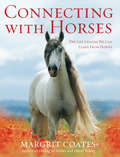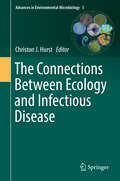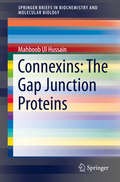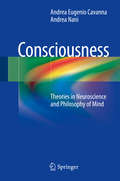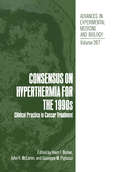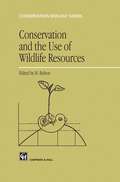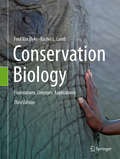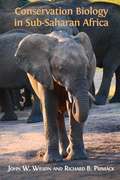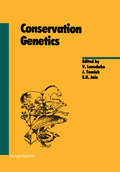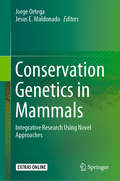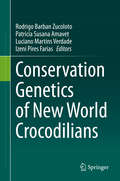- Table View
- List View
Concise Textbook of Equine Clinical Practice Book 4: Liver, Endocrine, Urinary, Skin and Wounds
by François-René Bertin Antonio Cruz Andy Durham Derek KnottenbeltThis concise, practical text covers the essential information veterinary students need to succeed in equine medicine and surgery, focussing on skin, urinary, liver and endocrine diseases. Written for an international readership, the book conveys the core information in an easily digestible, precise form with extensive use of bullet points, tables, flow charts, diagrams, lists, protocols and extensive illustrations. Part of a five-book series that extracts and updates key information from Munroe’s Equine Surgery, Reproduction and Medicine, Second Edition, the book distils best practice in a logical straightforward clinical-based approach. It details clinical anatomy, physical clinical examination techniques, diagnostic techniques and normal parameters, emphasising the things regularly available to general practitioners with minimal information of advanced techniques. The liver section is divided into clinical evaluation, diagnostic tests, possible causes and treatment. The diagnostic approach to endocrine disease is followed by specific diseases of the thyroid, parathyroid, pituitary gland, equine metabolic syndrome and other miscellaneous disorders. The approach to urinary tract problems includes information on diagnostic tests and imaging, renal diseases,,and diseases of the ureter, bladder and urethra. The approach to skin disease is discussed in detail, including relevant diagnostic tests. Following this, individual skin diseases are covered under the headings of genetic, infectious, immune-mediated, nutritional, endocrine, idiopathic, traumatic and neoplastic causes. Finally, skin wounds, burns and infections of synovial structures are discussed. Ideal for veterinary students and nurses on clinical placements with horses as well as practitioners needing a quick reference ‘on the ground’.
Concise Textbook of Equine Clinical Practice Book 4: Liver, Endocrine, Urinary, Skin and Wounds
by François-René Bertin Antonio Cruz Andy Durham Derek KnottenbeltThis concise, practical text covers the essential information veterinary students need to succeed in equine medicine and surgery, focussing on skin, urinary, liver and endocrine diseases. Written for an international readership, the book conveys the core information in an easily digestible, precise form with extensive use of bullet points, tables, flow charts, diagrams, lists, protocols and extensive illustrations. Part of a five-book series that extracts and updates key information from Munroe’s Equine Surgery, Reproduction and Medicine, Second Edition, the book distils best practice in a logical straightforward clinical-based approach. It details clinical anatomy, physical clinical examination techniques, diagnostic techniques and normal parameters, emphasising the things regularly available to general practitioners with minimal information of advanced techniques. The liver section is divided into clinical evaluation, diagnostic tests, possible causes and treatment. The diagnostic approach to endocrine disease is followed by specific diseases of the thyroid, parathyroid, pituitary gland, equine metabolic syndrome and other miscellaneous disorders. The approach to urinary tract problems includes information on diagnostic tests and imaging, renal diseases,,and diseases of the ureter, bladder and urethra. The approach to skin disease is discussed in detail, including relevant diagnostic tests. Following this, individual skin diseases are covered under the headings of genetic, infectious, immune-mediated, nutritional, endocrine, idiopathic, traumatic and neoplastic causes. Finally, skin wounds, burns and infections of synovial structures are discussed. Ideal for veterinary students and nurses on clinical placements with horses as well as practitioners needing a quick reference ‘on the ground’.
Concise Textbook of Equine Clinical Practice Book 5: Nervous System, Eyes, Cardiovascular Disorders and Haemolymphatic System
by Erin Beasley Graham Munroe François-René BertinThis concise, practical text covers the essential information veterinary students need to succeed in equine medicine and surgery, focusing on the nervous system, eyes, cardiovascular disorders and haemolymphatic systems. Written for an international readership, the book conveys the core information in an easily digestible, precise form with extensive use of bullet points, tables, flow charts, diagrams, lists, protocols and extensive illustrations. Part of a five-book series that extracts and updates key information from Munroe’s Equine Surgery, Reproduction and Medicine, Second Edition, the book distils best practice in a logical straightforward clinical-based approach. It details clinical anatomy, physical clinical examination techniques, diagnostic techniques and normal parameters, emphasising the things regularly available to general practitioners with minimal information of advanced techniques. The nervous system section discusses in detail the neurological exam, mentions relevant diagnostic tests and divides the diseases of the system into congenital, infectious, traumatic, toxin-induced and miscellaneous causes. In the eye section, the relevant anatomy and the examination of the eye are followed by discussion of useful diagnostic tests and procedures. Diseases of the eye are discussed under the headings of congenital/neonatal, neoplastic, infectious and inflammatory disorders, neurological based and parasitic problems. The cardiological examination and relevant diagnostic tests are followed by sections on arrhythmias, congenital and acquired cardiac diseases, pericardial disease and miscellaneous cardiovascular disease. Finally, the haemolymphatic section discusses in detail relevant diagnostic approaches and laboratory aids, followed by sections on anaemia, haemostasis disorders, infections and neoplasia. Ideal for veterinary students and nurses on clinical placements with horses, as well as practitioners needing a quick reference ‘on the ground’.
Concise Textbook of Equine Clinical Practice Book 5: Nervous System, Eyes, Cardiovascular Disorders and Haemolymphatic System
by Erin Beasley Graham Munroe François-René BertinThis concise, practical text covers the essential information veterinary students need to succeed in equine medicine and surgery, focusing on the nervous system, eyes, cardiovascular disorders and haemolymphatic systems. Written for an international readership, the book conveys the core information in an easily digestible, precise form with extensive use of bullet points, tables, flow charts, diagrams, lists, protocols and extensive illustrations. Part of a five-book series that extracts and updates key information from Munroe’s Equine Surgery, Reproduction and Medicine, Second Edition, the book distils best practice in a logical straightforward clinical-based approach. It details clinical anatomy, physical clinical examination techniques, diagnostic techniques and normal parameters, emphasising the things regularly available to general practitioners with minimal information of advanced techniques. The nervous system section discusses in detail the neurological exam, mentions relevant diagnostic tests and divides the diseases of the system into congenital, infectious, traumatic, toxin-induced and miscellaneous causes. In the eye section, the relevant anatomy and the examination of the eye are followed by discussion of useful diagnostic tests and procedures. Diseases of the eye are discussed under the headings of congenital/neonatal, neoplastic, infectious and inflammatory disorders, neurological based and parasitic problems. The cardiological examination and relevant diagnostic tests are followed by sections on arrhythmias, congenital and acquired cardiac diseases, pericardial disease and miscellaneous cardiovascular disease. Finally, the haemolymphatic section discusses in detail relevant diagnostic approaches and laboratory aids, followed by sections on anaemia, haemostasis disorders, infections and neoplasia. Ideal for veterinary students and nurses on clinical placements with horses, as well as practitioners needing a quick reference ‘on the ground’.
Concise Textbook of Large Animal Handling: A Practical Handbook
by C. B. ChastainThis concise instructional guide condenses the most important aspects of large animal handling. It provides a portable, durable, beside-the-animal means of learning, as well as a convenient way to refresh on how to strive for safety and efficacy in animal handling techniques. It is ideal for use during veterinary placements in all settings from farm to laboratory, to riding school. The text covers: • Handler safety • Animal safety • Sanitation • Approach and capture • Routine handling and release procedures • Handling for medical procedures • Use and supply sources of restraint equipment A Companion Website provides additional self-assessment questions and answers to aid learning. Important reading for undergraduate veterinary students on EMS rotations, as well as practicing veterinarians, technicians, and assistants, the book covers species encountered in farm, equine, and laboratory settings.
Concise Textbook of Large Animal Handling: A Practical Handbook
by C. B. ChastainThis concise instructional guide condenses the most important aspects of large animal handling. It provides a portable, durable, beside-the-animal means of learning, as well as a convenient way to refresh on how to strive for safety and efficacy in animal handling techniques. It is ideal for use during veterinary placements in all settings from farm to laboratory, to riding school. The text covers: • Handler safety • Animal safety • Sanitation • Approach and capture • Routine handling and release procedures • Handling for medical procedures • Use and supply sources of restraint equipment A Companion Website provides additional self-assessment questions and answers to aid learning. Important reading for undergraduate veterinary students on EMS rotations, as well as practicing veterinarians, technicians, and assistants, the book covers species encountered in farm, equine, and laboratory settings.
Concise Textbook of Small Animal Handling: A Practical Handbook
by C. B. ChastainThis instructional pocket reference condenses the most important aspects of small animal handling. It provides a portable, durable means of learning 'on the ground', as well as a convenient way to refresh on how to strive for safety and efficacy in animal handling techniques. Spiralbound for practical use at the animal’s side during veterinary placements in a clinic or laboratory, the text covers: Handler safety Animal safety Sanitation Approach and capture Routine handling and release procedures Handling for medical procedures Use and supply sources of restraint equipment A Companion Website provides additional self-assessment questions and answers to aid learning. Important reading for undergraduate veterinary students as well as practicing technicians, nurses and assistants, the book instructs on safe and humane handling of species encountered in both small animal practice and laboratory settings.
Concise Textbook of Small Animal Handling: A Practical Handbook
by C. B. ChastainThis instructional pocket reference condenses the most important aspects of small animal handling. It provides a portable, durable means of learning 'on the ground', as well as a convenient way to refresh on how to strive for safety and efficacy in animal handling techniques. Spiralbound for practical use at the animal’s side during veterinary placements in a clinic or laboratory, the text covers: Handler safety Animal safety Sanitation Approach and capture Routine handling and release procedures Handling for medical procedures Use and supply sources of restraint equipment A Companion Website provides additional self-assessment questions and answers to aid learning. Important reading for undergraduate veterinary students as well as practicing technicians, nurses and assistants, the book instructs on safe and humane handling of species encountered in both small animal practice and laboratory settings.
Conditioned Taste Aversion: Memory Of A Special Kind (Oxford Psychology Series #31)
by Jan Bures F. Bermudez-Rattoni T. YamamotoConditioned taste aversion (CTA) is a robust defence device protecting animals against repeated consumption of toxic food. It is characterised by the ability of many animals to learn to avoid certain substances by their sight, smell, or taste after experiencing an unpleasant or harmful reaction to them. CTA is encountered at all levels of evolution, with similar forms of food aversion learning found in vertebrate and invertebrate species whose ancestral lines diverged more than 500 million years ago. CTA has a number of unusual properties contrasting sharply with the basic assumptions of traditional learning theories, which has brought it increasingly to the attention of neurobiologists interested in neural plasticity. In CTA, the usual time parameters between stimulus and aversion are relaxed considerably, frequently with delays of hours rather than seconds. Moreover, the critical stage of CTA acquisition may proceed under deep anaesthesia incompatible with other forms of learning. In the past decade several pivotal discoveries have considerably avanced our understanding of the neural processes underlying CTA, and opened new possibilities for their analysis at the molecular and cellular levels. This book, written by three of the world's leading researchers in the subject, comprehensively reviews the current state of research into conditioned taste aversion. The first book of its kind to provide an up-to-date summary of research into the neuroanatomy, pharmacology, electrophysiology, and functional morphology of CTA, it will be welcomed by all researchers and graduate students in the field.
The Condor's Feather: Travelling Wild in South America
by Michael Webster'A thrilling, deeply emotional and authentic bird-lover's travelogue.' James Lowen, author of Much Ado About Mothing'One spring morning, as the cuckoos were arriving in England, we departed. At Tilbury Docks we slowly edged our Toyota camper into a shipping container and, like a heron scooping a frog from a marsh, our container was hoisted high over the dockside. Inside was everything we needed, our new life bound for South America.'After a vicious attack left Michael Webster in treatment for years, it was only his love of nature - in particular birds - that truly healed. Repaying this debt to nature, he and his wife embarked on their trip of a lifetime, travelling through South America; immersed in the wild, following and filming birds.For over four years Michael and Paula travelled the length of the Andes, the greatest mountain chain on Earth. From penguins in Patagonia, up beyond the hummingbirds of the equator, to the flamingos of the Caribbean. They endured dust storms, thundering gales, icy mountain tops and skin-searing heat, and tested the limits of their physical and mental strength as they lived wild, month after month, camping under galaxies of diamond stars.The Condor's Feather is testament to the possibility of new adventures, new friendships and new hope.
Confocal Microscopy for Biologists (Disease Management Of Fruits And Vegetables Ser.)
by Alan R. HibbsThere has been a great upsurge in interest in light microscopy in recent years due to the advent of a number of significant advances in microscopy, one of the most important of which is confocal microscopy. Confocal microscopy has now become an important research tool, with a large number of new fluorescent dyes becoming available in the past few years, for probing your pet structure or molecule within fixed or living cell or tissue sampies. Many of the people interested in using confocal microscopy to further their research do not have a background in microscopy or even cell biology and so not only do they find considerable difficulty in obtaining satisfactory results with a confocal microscope, but they may be mislead by how data is being presented. This book is intended to teach you the basic concepts ofmicroscopy, fluorescence, digital imaging and the principles of confocal microscopy so that you may take full advantage ofthe excellent confocal microscopes now available. This book is also an excellent reference source for information related to confocal microscopy for both beginners and the more advanced users. For example, do you need to know the optimal pinhole size for a 63x 1. 4 NA lens? Do you need to know the fluorescence emission spectrum of Alexa 568? Access to the wealth of practical information in this book is made easier by using both the detailed index and the extensive glossary.
Conkers – D-Day Dog (Conkers)
by Tom PalmerMaster storyteller Tom Palmer returns with a touching celebration of the heroic paratroopers of WWII and their parachuting canine companions.
Connecting with Horses: The Life Lessons We Can Learn from Horses
by Margrit CoatesMargrit Coates is internationally acclaimed for her work as an animal healer and communicator, and is the author of Healing with Horses and Horses Talking. Now, for the first time, she explains how horses can offer healing and guidance to us, the people in their lives.Connecting with Horses explores the key lessons that we can learn from these magnificent animals. When we really understand how to interact with horses and how to interpret their roles in our lives, we will learn how to improve our relationships with others and much more. This extraordinary book draws upon powerful true stories and practical experience to explore themes and offer profound insights ranging from creativity through to potential and success. As you will discover, even your own horse or pony is an incredible animal that has much to teach you...
The Connections Between Ecology and Infectious Disease (Advances in Environmental Microbiology #5)
by Christon J. HurstThis book summarizes current advances in our understanding of how infectious disease represents an ecological interaction between a pathogenic microorganism and the host species in which that microbe causes illness. The contributing authors explain that pathogenic microorganisms often also have broader ecological connections, which can include a natural environmental presence; possible transmission by vehicles such as air, water, and food; and interactions with other host species, including vectors for which the microbe either may or may not be pathogenic. This field of science has been dubbed disease ecology, and the chapters that examine it have been grouped into three sections. The first section introduces both the role of biological community interactions and the impact of biodiversity on infectious disease. In turn, the second section considers those diseases directly affecting humans, with a focus on waterborne and foodborne illnesses, while also examining the critical aspect of microbial biofilms. Lastly, the third section presents the ecology of infectious diseases from the perspective of their impact on mammalian livestock and wildlife as well as on humans. Given its breadth of coverage, the volume offers a valuable resource for microbial ecologists and biomedical scientists alike.
Connexins: The Gap Junction Proteins (SpringerBriefs in Biochemistry and Molecular Biology)
by Dr. Mahboob HussainGap-junction proteins, connexins are important cellular entities that regulate various facets of cellular physiology. The connexins constitute large family of proteins. The present book provides basic overview about various aspects of connexin proteins. The book has tried to touch the fundamental aspects of connexin family. This book will be useful to broad audience that includes under-and post-graduate students, research scholars, clinicians, etc. The reference section at the end of the book will be helpful for those who seek to know deeper details about this family of proteins.
Consciousness: Theories in Neuroscience and Philosophy of Mind
by Andrea Eugenio Cavanna Andrea NaniThis book reviews some of the most important scientific and philosophical theories concerning the nature of mind and consciousness. Current theories on the mind-body problem and the neural correlates of consciousness are presented through a series of biographical sketches of the most influential thinkers across the fields of philosophy of mind, psychology and neuroscience. The book is divided into two parts: the first is dedicated to philosophers of mind and the second, to neuroscientists/experimental psychologists. Each part comprises twenty short chapters, with each chapter being dedicated to one author. A brief introduction is given on his or her life and most important works and influences. The most influential theory/ies developed by each author are then carefully explained and examined with the aim of scrutinizing the strengths and weaknesses of the different approaches to the nature of consciousness.
Consensus on Hyperthermia for the 1990s: Clinical Practice in Cancer Treatment (Advances in Experimental Medicine and Biology #267)
by Haim I. Bicher John R. McLaren Giuseppe M. PigliucciHyperthermia as a safe and effective cancer treatment modality is rapidly evolving propelled by widespread research and clinical efforts worldwide. Presentations on Hyperthermia experience are now commonplace at Oncology meetings, as are congresses dedicated entirely to the intertwined interactions between basic sciences and patient treatment that together are forming the structure of a new medical specialty. Such was the XII International Symposium on Clinical Hyperthermia held in Rome, Italy, April 27 - 29, 1989. Papers presented therein constitute the backbone of this book. Biology research has provided data describing mechanisms of action for the cancer cell killing and physiological effects of Hyperthermia. Physics research has led to the development of equipment enabling treatment of many areas of the human body, as well as explained the limitations that still constrain our ability to treat, especially in the areas of deep seated tumor heating and non-invasive thermometry. The main question that will decide the future of this modality is that of its clinical use. To put it succinctly, what do we do with this potentially useful tool in an everyday clinical oncological practice . •• ? This is the main question addressed in this book as "Consensus on Hyperthermia for the 1990s. " The book in cludes 28 presented papers and 25 invited chapters from some of the leading experts in the field. Their basic mechanisms of action were physics principles, treatment quality assurance and especially, clinical indications.
Conservation and the Use of Wildlife Resources (Conservation Biology #8)
by M. Bolton Jeannette L. JohnsonNot everybody cares about the fate of wild animals or the state of the natural environment. I met a lady who said it wouldn't worry her if all the wild animals in the world disappeared overnight. She was a city person~ she said. There are also people who would prefer to let animals become extinct than to have them kept in captivity - no matter how progressive the zoo. There are those who, on principle, will not eat meat, let alone do the killing, and there are those who enjoy nothing so much as shooting birds. People in the last two camps may oppose each other in claiming to be con servationists. Extremists are unlikely to find their opinions being reversed by this book but, because of the scope of the subject, I believe there is a good chance that anybody with an interest in wildlife will find in it something new to think about. It may not be too much to hope that a few disagreements might also be settled because I suspect there is more common ground than is generally realized among those with opposing views.
Conservation Behavior: Applying Behavioral Ecology To Wildlife Conservation And Management (PDF) (Conservation Biology Ser. #21)
by Oded Berger-Tal David SaltzConservation behavior assists the investigation of species endangerment associated with managing animals impacted by anthropogenic activities. It employs a theoretical framework that examines the mechanisms, development, function, and phylogeny of behavior variation in order to develop practical tools for preventing biodiversity loss and extinction. Developed from a symposium held at the International Congress on Conservation Biology in 2011, this is the first book to offer an in-depth, logical framework that identifies three vital areas for understanding conservation behavior: anthropogenic threats to wildlife, conservation and management protocols, and indicators of anthropogenic threats. Bridging the gap between behavioral ecology and conservation biology, this volume ascertains key links between the fields, explores the theoretical foundations of these linkages, and connects them to practical wildlife management tools and concise applicable advice. Adopting a clear and structured approach throughout, this book is a vital resource for graduate students, academic researchers, and wildlife managers.
Conservation Biology: Foundations, Concepts, Applications
by Rachel L. Lamb Fred Van DykeThis book provides a thorough, up-to-date examination of conservation biology and the many supporting disciplines that comprise conservation science. In this, the Third Edition of the highly successful Conservation Biology: Foundations, Concepts, Applications, the authors address their interdisciplinary topic as it must now be practiced and perceived in the modern world. Beginning with a concise review of the history of conservation, the authors go on to explore the interplay of conservation with genetics, demography, habitat and landscape, aquatic environments, and ecosystem management, and the relationship of all these disciplines to ethics, economics, law, and policy. An entirely new chapter, The Anthropocene: Conservation in a Human-Dominated Nature, breaks new ground in its exploration of how conservation can be practiced in anthropogenic biomes, novel ecosystems, and urban habitats. The Third Edition includes the popular Points of Engagement discussion questions used in earlier editions, and adds a new feature: Information Boxes, which briefly recap specific case histories described in the text. A concluding chapter offers insight into how to become a conservation professional, in both traditional and non-traditional roles.The authors, Fred Van Dyke and Rachel Lamb, draw on their expertise as field biologists, wildlife managers, consultants to government and industry, and scholars of environmental law, policy, and advocacy, as well as their many years of effective teaching experience. Informed by practical knowledge and acquired skills, the authors have created a work of exceptional clarity and readability which encompasses both systemic foundations as well as contemporary developments in the field. Conservation Biology: Foundations, Concepts, Applications will be of invaluable benefit to undergraduate and graduate students, as well as to working conservation scientists and managers.This is an amazing resource for students, faculty, and practitioners both new and experienced to the field. Diane Debinski, PhD Unexcelled wisdom for living at home on Wonderland Earth, the planet with promise, destined for abundant life. Holmes Rolston, PhDVan Dyke and Lamb have maintained the original text’s emphasis on connecting classical ecological and environmental work with updated modern applications and lucid examples. But more importantly, the third edition contains much new material on the human side of conservation, including expanded treatments of policy, economics, and climate change. Tim Van Deelen, PhD Fred Van Dyke and Rachel Lamb break new ground in both the breadth and depth of their review and analysis of this crucially important and rapidly changing field. Any student or other reader wishing to have a comprehensive overview and understanding of the complexities of conservation biology need look no further – this book is your starting point! Simon N. Stuart, PhD
Conservation Biology in Sub-Saharan Africa
by John W. Wilson Richard B. PrimackConservation Biology in Sub-Saharan Africa comprehensively explores the challenges and potential solutions to key conservation issues in Sub-Saharan Africa. Easy to read, this lucid and accessible textbook includes fifteen chapters that cover a full range of conservation topics, including threats to biodiversity, environmental laws, and protected areas management, as well as related topics such as sustainability, poverty, and human-wildlife conflict. This rich resource also includes a background discussion of what conservation biology is, a wide range of theoretical approaches to the subject, and concrete examples of conservation practice in specific African contexts. Strategies are outlined to protect biodiversity whilst promoting economic development in the region. Boxes covering specific themes written by scientists who live and work throughout the region are included in each chapter, together with recommended readings and suggested discussion topics. Each chapter also includes an extensive bibliography. Conservation Biology in Sub-Saharan Africa provides the most up-to-date study in the field. It is an essential resource, available on-line without charge, for undergraduate and graduate students, as well as a handy guide for professionals working to stop the rapid loss of biodiversity in Sub-Saharan Africa and elsewhere.
Conservation Genetics (Experientia Supplementum #68)
by V. Loeschcke J. Tomiuk S. K. JainIt follows naturally from the widely accepted Darwinian dictum that failures of populations or of species to adapt and to evolve under changing environments will result in their extinction. Population geneti cists have proclaimed a centerstage role in developing conservation biology theory and applications. However, we must critically reexamine what we know and how we can make rational contributions. We ask: Is genetic variation really important for the persistence of species? Has any species become extinct because it ran out of genetic variation or because of inbreeding depression? Are demographic and environmental stochas ticity by far more important for the fate of a population or species than genetic stochasticity (genetic drift and inbreeding)? Is there more to genetics than being a tool for assessing reproductive units and migration rates? Does conventional wisdom on inbreeding and "magic numbers" or rules of thumb on critical effective population sizes (MVP estimators) reflect any useful guidelines in conservation biology? What messages or guidelines from genetics can we reliably provide to those that work with conservation in practice? Is empirical work on numerous threatened habitats and taxa gathering population genetic information that we can use to test these guidelines? These and other questions were raised in the invitation to a symposium on conservation genetics held in May 1993 in pleasant surroundings at an old manor house in southern Jutland, Denmark.
Conservation Genetics in Mammals: Integrative Research Using Novel Approaches
by Jorge Ortega Jesus E. MaldonadoThis book focuses on the use of molecular tools to study small populations of rare and endangered mammals, and presents case studies that apply an evolutionary framework to address innovative questions in the emerging field of mammalian conservation genomics using a highly diverse set of novel molecular tools. Novel and more precise molecular technologies now allow experts in the field of mammology to interpret data in a more contextual and empirical fashion and to better describe the evolutionary and ecological processes that are responsible for the patterns they observe. The book also demonstrates how recent advances in genetic/genomic technologies have been applied to assess the impact of environmental/anthropogenic changes on the health of small populations of mammals. It examines a range of issues in the field of mammalian conservation genomics, such as the role that the genetic diversity of the immune system plays in disease protection and local adaptation; the use of noninvasive techniques and genomic banks as a resource for monitoring and restoring populations; the structuring of population by physical barriers; and genetic diversity. Further, by integrating research from a variety of areas – including population genetics, molecular ecology, systematics, and evolutionary and conservation biology – it enables readers to gain a deeper understanding of the conservation biology of mammals that are at increasing risk of extinction at local, regional and global scales. As such, it offers a unique resource for a broad readership interested in the conservation biology of mammals and conservation management strategies to better preserve biodiversity.
Conservation Genetics of New World Crocodilians
by Rodrigo Barban Zucoloto Patricia Susana Amavet Luciano Martins Verdade Izeni Pires FariasThis book aims to be a comprehensive review of the literature on the conservation genetics of the New World crocodilians, from the biological and demographical aspects of the living species to the application of molecular techniques for conservation purposes. It covers the current status of the molecular genetics applied to phylogenetics, phylogeography, diversity, kinship and mating system, and hybridization, as well its implications for decision making with regards to the conservation of these species at academic and governmental levels. This book can be used as a guide for graduate and undergraduate students to understand how conservation genetics techniques are carried out and how they can help preserve not only crocodilians but also other living species.
